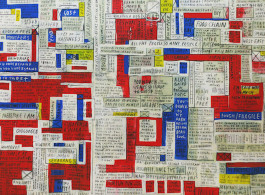Space Cottonseed is proud to present Writing an Image, a group exhibition of five artists, Farid Stevy Asta, Wisnu Auri, Indra Dodi, Youn Seuk Oh and Seungho Yoo, who have been practicing art in relation to text and writing. In their works, the distinction between an image and a text is blurred, obscured, and is explored in a number of ways. The show questions whether the texts appearing in their works are written texts or drawn images. It explores the relationship between the image and the text in their works, showing how text is embraced as a symbolic image or a delivery system for meaning. Writing an Image will bring an opportunity to introduce diverse art practices that impose different functions to an image or a text, and poses questions about the artists’ practices of writing an image, as well as drawing letters.
Farid Stevy Asta from Yogyakarta is an artist, graphic designer and well-known singer-song writer. Collecting words and letters is the first step for him to write lyrics for his songs. Asta’s series of painting and drawing are a fountain of words that is visualized through writing, drawing, scribbling and so on. Influenced by Jean Paul Baskiat and Mondrian, there is an irony in Asta’s work: it has both fabrics of geometry and graffiti, reason and intuition. The most interesting thing about Asta’s work is that words are the courses for sound. Figure becomes abstract in a very different way of art practice. However, we still can see his song as a visualized form. Can we see to read a lyrics or listen to a song?
For Wisnu Auri from Yogyakarta, the boundary between the text and image are blurred. On canvas, the artist writes a question “Are we painting, or coloring?” His question is a statement that locates the work in a complex: do we read or see the painting? Juxtaposing lumps and splashes of colors with two words ‘Beauty’ and ‘Landscape,’ again Auri poses a question to the audience through the title of the work Enter Words. On your mobile phone, you can search what you are looking for when you ‘enter words.’ Where does it take you to? Ideas, languages, and visual elements such as color and images are carefully calculated and composed in his work.
Indra Dodi, also from Yogyakarta, has been using child-like painting techniques. Like a child drawing or scribbling on his drawing book, Dodi has produced works with images as well as texts. Although it is not conceptual but personal he questions our perspective in observing the object. Most of his subjects are from his everyday life such as his village, rocks, mountains, rivers, rain, clouds, parties, love, drink, women, children and so on. In his work, letters do not mean anything particular. Like a child who cannot read letters yet, in Dodi’s perspective, letters are only one of the visual elements that compose the world around him. Or, probably the letters can be a code that can be only decoded by the artist as we can see in his work White Diary.
Through letters, human being has visualized their abstract thoughts of human. In works by Youn Seok Oh, from Daejon, Korea, he accepts texts related with Buddhist scriptures and Korean folk religion as their structural meaning and formal contents. The texts in Oh’s work are not readable. What his work reveals commonly is that the artist does not distinguish art and his life. Similar to old history of transcript by monks, Oh deliberately transcribes religious contents onto his work. It is not necessary readable as long as the process of transcribing is the core of his practice. What the audience can see is an artwork born through time and life of the artist.
Seungho Yoo has developed a very unique way of painting on his own. Unless the viewer takes a closer look at his work, Yoo’s work is merely a landscape painting. But once the viewer discerns that the image is not painted but written with thousands of letters, they realize that what they see is not simply a landscape. The image becomes flocks of letters floating in an abstract space. In Yoo’s work, a text and an image inseparably coexist. These two elements of the work inseparably reference each other in his work.



